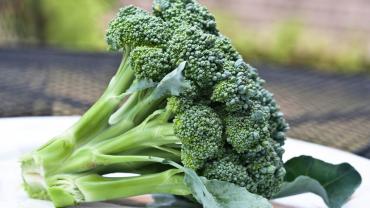
Broccoli: it’s the bane of existence of many a toddler and adolescent whose health-conscious parents withhold dessert until they’ve managed to get down every last bit of green vegetable on their plate. But like their cruciferous cousins—Brussels sprouts—when cooked the right way broccoli transforms from ho-hum to holy cow! From bitter boiled soggy and bland to something that will have kids and adults flocking to the table and asking for seconds.
This tiny tree resembling vegetable is jam-packed with vitamins C and K folate and it’s also a source of B6 manganese and small amounts of carotenoids. Beyond its basic vitamins and minerals broccoli is also a source of quercetin a compound more frequently associated with red onions and cranberries. Red apples are also often cited as a source of quercetin and ounce for ounce broccoli provides almost as much of this anti-inflammatory and antioxidant flavonoid. Like other non-starchy vegetables broccoli fits in well with a number of different dietary strategies including Paleo low carb ketogenic low fat vegetarian and vegan. It’s very low in carbohydrate and high in fiber with a glycemic load that’s almost negligible. It seems like the only people who would need to avoid broccoli are those who might be allergic to it or those who simply don’t like it. But there are plenty of recipes to change the minds of the latter—we’ll get to those in a bit.
Being in the cruciferous category broccoli is rich in sulfur—a fact that reveals itself via a distinctive “aroma” any time broccoli is steamed or microwaved. While the smell of plainly cooked broccoli isn’t all that appealing the presence of the sulfur (as the compound sulforaphane) is responsible for many of the health-promoting properties of broccoli. Broccoli is also a source of indol-3-carbinol which is metabolized to diindolylmethane (a.k.a. DIM) which is well regarded for helping to support detoxification of excess estrogen and may also be beneficial for arresting the cell cycle and inducing apoptosis in various types of cancer cells.
Some of the beneficial compounds in broccoli are altered during cooking. For example according to one study steaming may boost the sulforaphane and antioxidant activity likely owing to an increase in extractability/bioavailability. Freezing and boiling broccoli may reduce the concentration of polyphenols due mainly “to volatilization and leaching into the cooking water.” (The latter isn’t a problem if you’re making broccoli soup!) Other studies found similar results: compared to raw broccoli steamed broccoli has a higher content of polyphenols and glucosinolates while cooking in water has the opposite effect. Steaming does not reduce the vitamin C content of broccoli whereas cooking in water does so significantly. According to a study that assessed changes to the nutrient content of broccoli upon different cooking methods “Both water- and steam-cooking of broccoli results in an increase in beta-carotene lutein and alpha- and gamma-tocopherols as compared with fresh broccoli. Similar effects of steaming and water-cooking of broccoli on their antioxidant activity were observed.”
Microwaving is a pretty popular way to cook broccoli but it presents some of the challenges just discussed: leaching of nutrients into cooking water. There are microwave steamers available though wherein the broccoli wouldn’t be sitting directly in the water and would likely lose fewer nutrients as with a stovetop steamer or metal pot insert. Vitamin C phenolic compounds and glucosinolates were lost mostly to degradation and leaching in microwaving while minerals were preserved. Researchers recommend using a shorter cooking time and a smaller amount of water when cooking broccoli in a microwave to minimize nutrient losses (for those of you who do use microwaves that is.)
That the nutrients in cooked broccoli are more easily extracted than those from raw broccoli is good news for those who aren’t fans of munching on the raw version. (Have fun chewing; see you in about a week! Why do they always include raw broccoli florets in crudité platters anyway? Getting broccoli stuck between your teeth doesn’t help anyone make a good impression at a dinner party or business meeting!)
So how do you prepare broccoli in a way that garners rave reviews instead of sighs of dread at the dinner table? Roasting it is always a winner and it couldn’t be simpler. You can spice it up a bit with garlic and chili and you can even make grain-free broccoli pancakes! If you don’t mind chewing raw broccoli this broccoli salad with apple and walnuts would be a hit at a party and if you let the broccoli sit in the dressing for a day or two in advance it would soften up and become more tender. (Add the walnuts and apples closer to serving so they don’t get soggy.) This recipe for broccoli salad with bacon and golden raisins is a great way to lend sweet and salty flavors to the relatively open canvass broccoli provides.